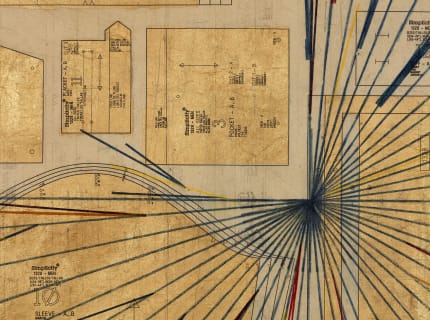The Krannert Art Museum’s a l l s t a r s exhibit arrives at a perfect moment, just as the museum reopens its Andean Art Before 1600 galleries. Artist Ronny Quevedo’s exploration of his Andean heritage, immigrant experience, and the democratic spaces of sport creates an unexpected dialogue between contemporary practice and ancient tradition. I spoke with KAM’s co-curators Amy L. Powell, Curator of Modern and Contemporary Art, and Allyson Purpura, Senior Curator and Curator of Global African Art, about this installation, which includes two rooms, with the second room designated for a larger piece specifically designed to fit the space.
When walking through the exhibition and interviewing the curators, Powell explained that the artist has a particular focus on deconstructing ballcourts or sport spaces — not only because he grew up with a father who was a soccer player and referee, but also because these were sites Quevedo saw as places “where lots of different kinds of people, especially immigrant communities to the United States, come to play and things can be rearranged or shifted.” We see this in particular with a few pieces, specifically History of Rules and Measures #2 and #3. Both show the boundaries across athletic spaces and how over time these spaces can be places of possibility or of entry. As I noticed with History of Rules and Measures #3, the possibilities are twofold for the viewer, not only with the lines marking the different sections of the court, but also the layered brown lines going across the piece, which are akin to the visual notation of music being played or the lines of a score.
One of the thrills I had during this exhibit was noting the repurposing of working-class materials that Quevedo uses. His mother was a seamstress (like my own), and he repurposed some of her sewing patterns to create pieces. As Powell relayed, “he leaves [these materials] there as he wants people to see what he’s using.” We see this in my mother’s hand, which is made of an old sewing pattern, thread, and wax on unstretched muslin. The pattern dominates in this piece as the measurements, the pattern number, and pieces of the original pattern shape are still readily apparent. The thread and wax form a background to the pattern, but add the feeling of a structure almost hiding within it—a drawing of his mother. For me, I had a visceral response to this work, as I felt reminded of my own love for my mother and the love Quevedo conveyed for his.
...
Read full article at smilepolitely.com

